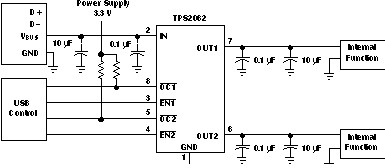SLVS490K December 2003 – June 2024
PRODUCTION DATA
- 1
- 1 Features
- 2 Applications
- 3 Description
- 4 Description (continued)
- 5 Pin Configuration and Functions
- 6 Specifications
- 7 Parameter Measurement Information
- 8 Detailed Description
-
9 Application and Implementation
- 9.1
Application Information
- 9.1.1 Power-supply Considerations
- 9.1.2 OC Response
- 9.1.3 Power Dissipation and Junction Temperature
- 9.1.4 Thermal Protection
- 9.1.5 Undervoltage Lockout (UVLO)
- 9.1.6 Universal Serial Bus (USB) Applications
- 9.1.7 Host/Self-Powered and Bus-powered Hubs
- 9.1.8 Low-power Bus-powered and High-Power Bus-Powered Functions
- 9.1.9 USB Power-distribution Requirements
- 9.1.10 Generic Hot-Plug Applications
- 9.1
Application Information
- 10Device and Documentation Support
- 11Revision History
- 12Mechanical, Packaging, and Orderable Information
9.1.8 Low-power Bus-powered and High-Power Bus-Powered Functions
Both low-power and high-power bus-powered functions obtain all power from upstream ports; low-power functions always draw less than 100 mA; high-power functions must draw less than 100 mA at power up and can draw up to 500 mA after enumeration. If the load of the function is more than the parallel combination of 44 Ω and 10 μF at power up, the device must implement inrush current limiting (see Figure 9-4). With TPS206x, the internal functions can draw more than 500 mA, which fits the needs of some applications such as motor driving circuits.
 Figure 9-4 High-Power Bus-Powered Function
Figure 9-4 High-Power Bus-Powered Function